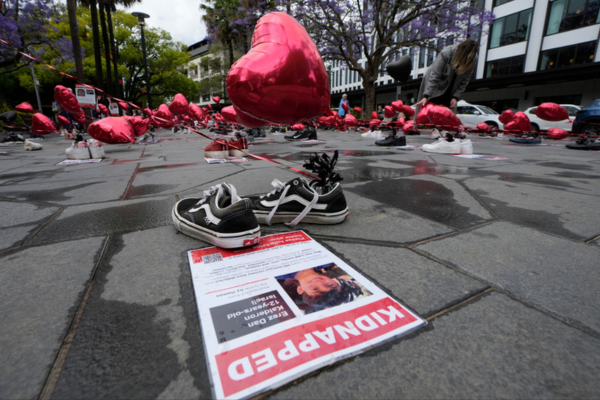Is Australia’s potential recognition of a Palestinian state rewarding terrorism or fostering peace?
By David May, Algemeiner
Terrorism pays. That is the message Australia’s government is sending by considering recognizing a Palestinian state in the wake of Hamas’ October 7 attack, something Foreign Minister Penny Wong recognized as, “The greatest loss of Jewish life in a single day since the Holocaust.”
The previous Australian government was exceptionally pro-Israel. That government recognized the western portion of Jerusalem, an area that would remain under Israeli control in any conceivable peace deal, as Israel’s capital, proscribed Hezbollah as a terrorist group in its entirety, and adopted the world’s leading definition of antisemitism, which includes examples of how anti-Israel activism bleeds into antisemitism.
But Prime Minister Anthony Albanese — a founding member of Australia’s Parliamentary Friends of Palestine group — has charted a different path since taking office in 2022. He overturned his country’s decision to recognize western Jerusalem as Israel’s capital. Albanese’s government also doubled funding to UNRWA, the Palestinian welfare agency that has since been implicated in aiding and allowing Hamas’ military preparations for the October 7 massacre.
Furthermore, in August 2023, Albanese’s administration upended nearly a decade of precedent by referring to the West Bank, eastern Jerusalem, and Gaza as “occupied Palestinian territories” rather than “disputed” lands. In 2014, Australia’s attorney general said his government would stop using the term “occupied” because it was unhelpful to “describe areas of negotiation in such judgmental language.”
Wong continued her government’s worrisome trajectory in an April 9 speech, promoting the recognition of a Palestinian state. Wong billed this as a way to advance Israeli security. She anticipated the criticism of this approach: “There are always those who claim recognition is rewarding an enemy. This is wrong.” But her approach clearly rewards Hamas.
A key pillar of Wong’s misguided approach is the idea that “there is no role for Hamas in a future Palestinian state.” This is unusually optimistic at best, and delusional at worst. Of course, Hamas, the ruthless terrorist group that uses Palestinians as human shields should be excluded from governance. But Hamas won the most recent parliamentary elections in 2006. Current polling shows that Hamas is the most popular Palestinian group. If Hamas survives its war with Israel (which it will if Australia gets its way and a ceasefire is implemented now), no one will be able to stop it from having a leading or even dominant role in a Palestinian state.
Wong’s approach also rewards Hamas for torpedoing efforts to improve ties between Israel and its Arab neighbors. Wong said, “the normalisation agenda that was being pursued before October 7 cannot proceed without progress on Palestinian statehood.” In other words, Canberra wants to give Palestinians the ability to veto additional Arab states making peace with Israel and recognizing it diplomatically. And for as long as Hamas exists, that means giving Hamas a share of the veto and a majority of the credit for it.
Relatedly, pushing for Palestinian statehood now would show that Hamas’ “resistance” strategy has worked, while the Palestinian Authority’s nominal commitment to engaging with Israel has failed. This would give the terrorist group invaluable political ammunition in its struggle with Palestinian rivals. Two recent examples of Israeli-Palestinian history make this point abundantly clear.
The popularization of a two-state solution to the Israeli-Palestinian conflict was the result of the First Intifada, a violent assault against Israel that began in late 1987. The Madrid Conference of 1991 and the Oslo Accords of 1993 and 1995 convinced many Palestinians of the effectiveness of violence as a method of extracting concessions from Israel. The desire to extract further concessions from Israel might have factored into Palestinian President Yasser Arafat’s decision to walk away from the Camp David Summit in 2000, where the Israelis offered to recognize a Palestinian state in the West Bank and Gaza. Instead, Arafat launched the Second Intifada, which was far bloodier than the first. During and after the Second Intifada, increasingly generous peace offers to the Palestinians — which the Palestinians rejected or ignored — only reinforced the idea that violence is a winning strategy.
Another concession to the Palestinians also aided Hamas’ rise to power. In 2005, Israeli Prime Minister Ariel Sharon executed the Disengagement Plan to remove all Israelis from Gaza. Hamas’ electoral victory the following year reflected the group’s increased popularity following disengagement. In fact, Hamas was able to capitalize on the perception that its attacks on Israelis forced the Jewish State to vacate Gaza.
Australia’s government is poised to fall into the trap of rewarding Palestinian violence. If Canberra truly believes that Hamas has no role in a future Palestinian state, it should assist Israel’s efforts to eliminate the terrorist group running Gaza. Once that is complete, recognition of Palestinian statehood, via direct Israeli-Palestinian negotiations, would help Palestinians. Until then, premature recognition of a Palestinian state would be a boon to Hamas.
